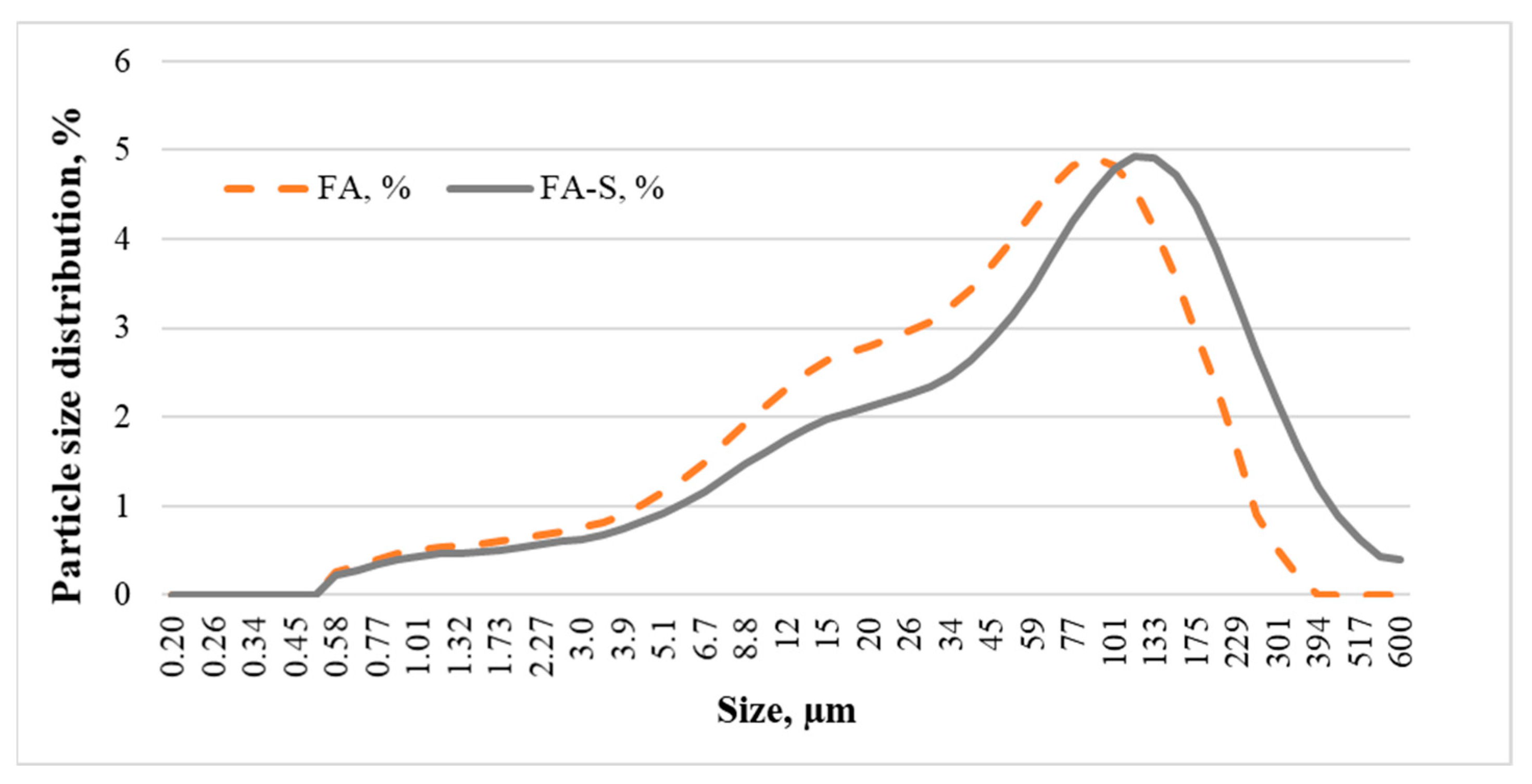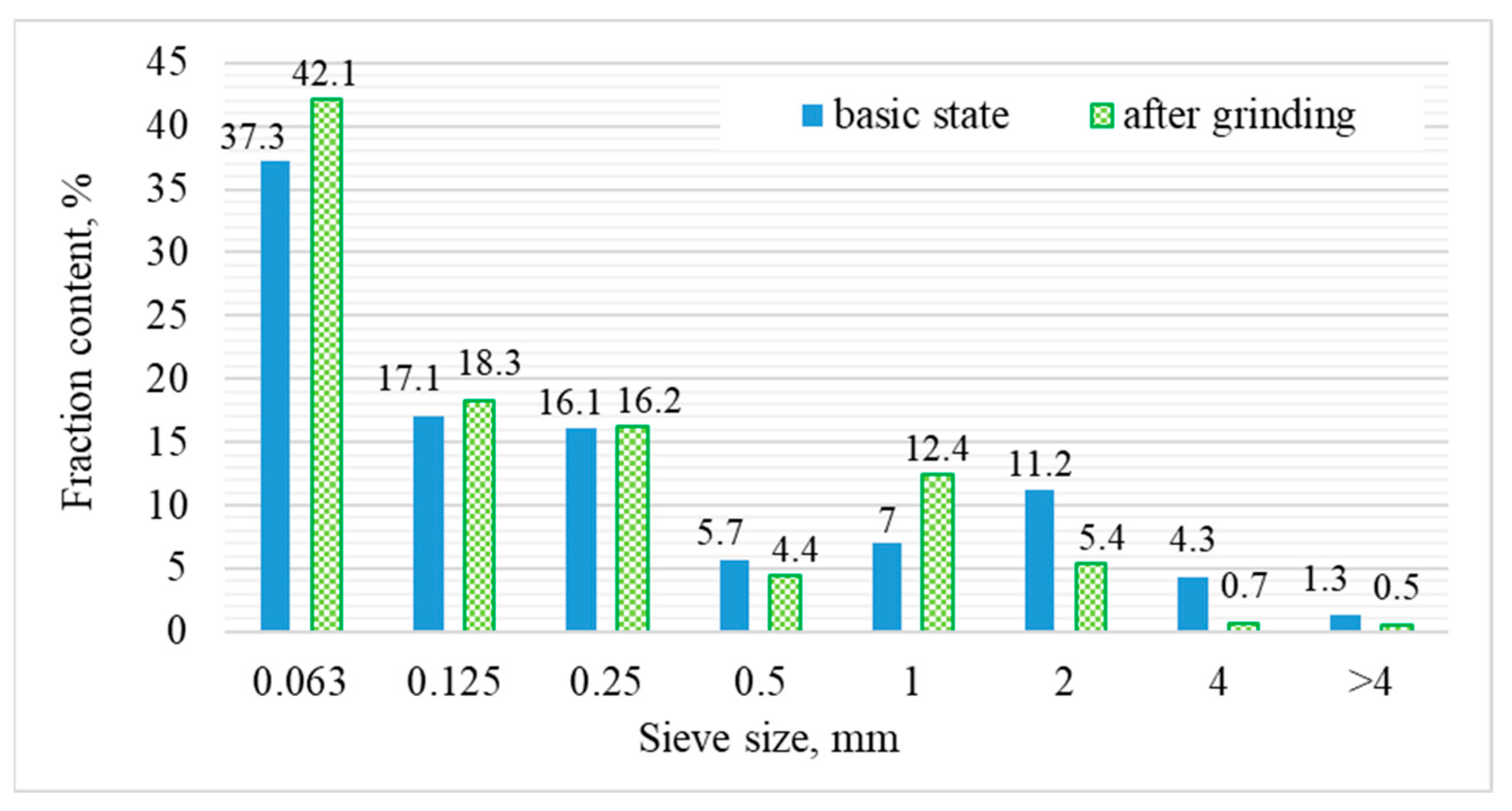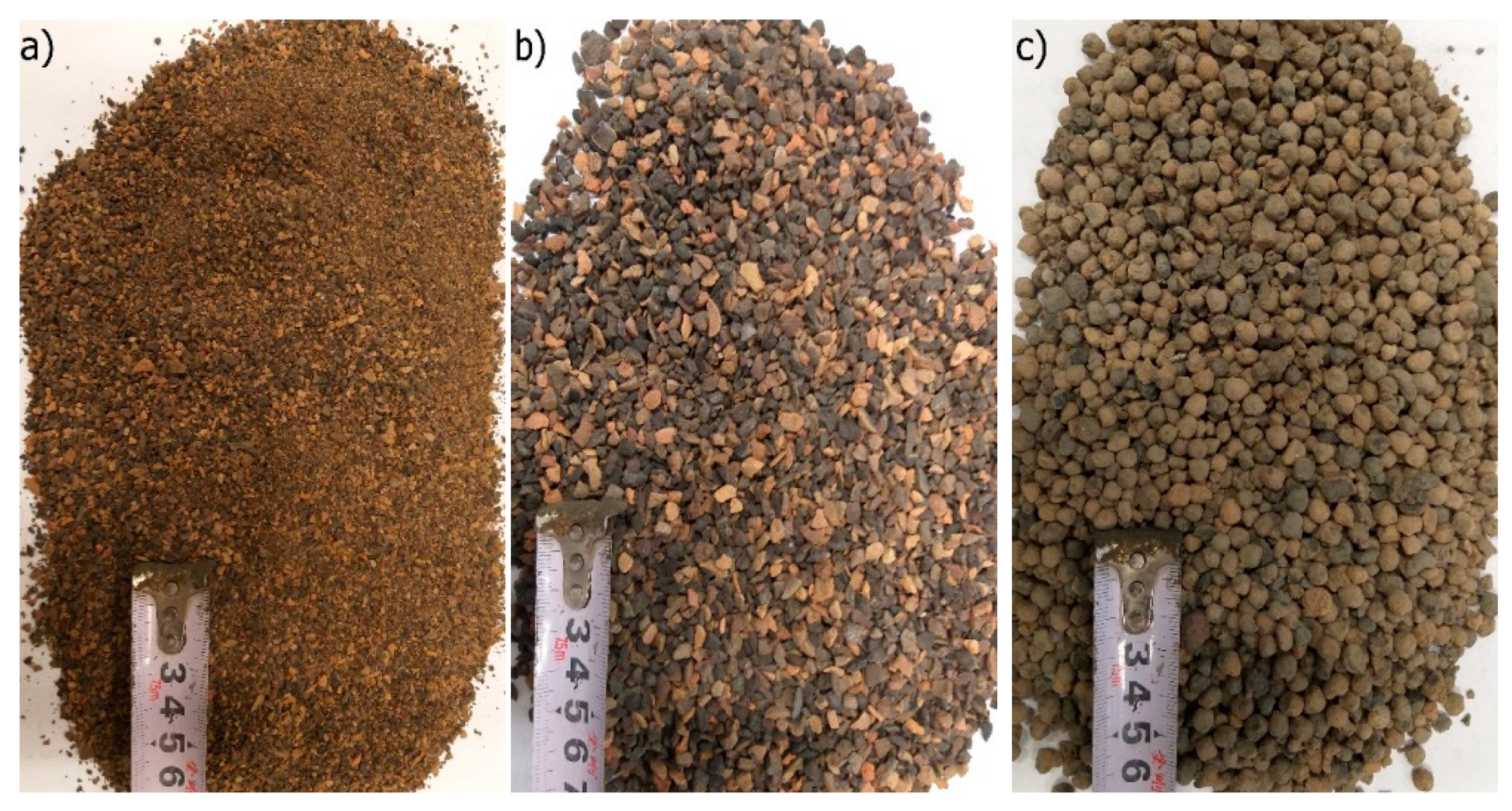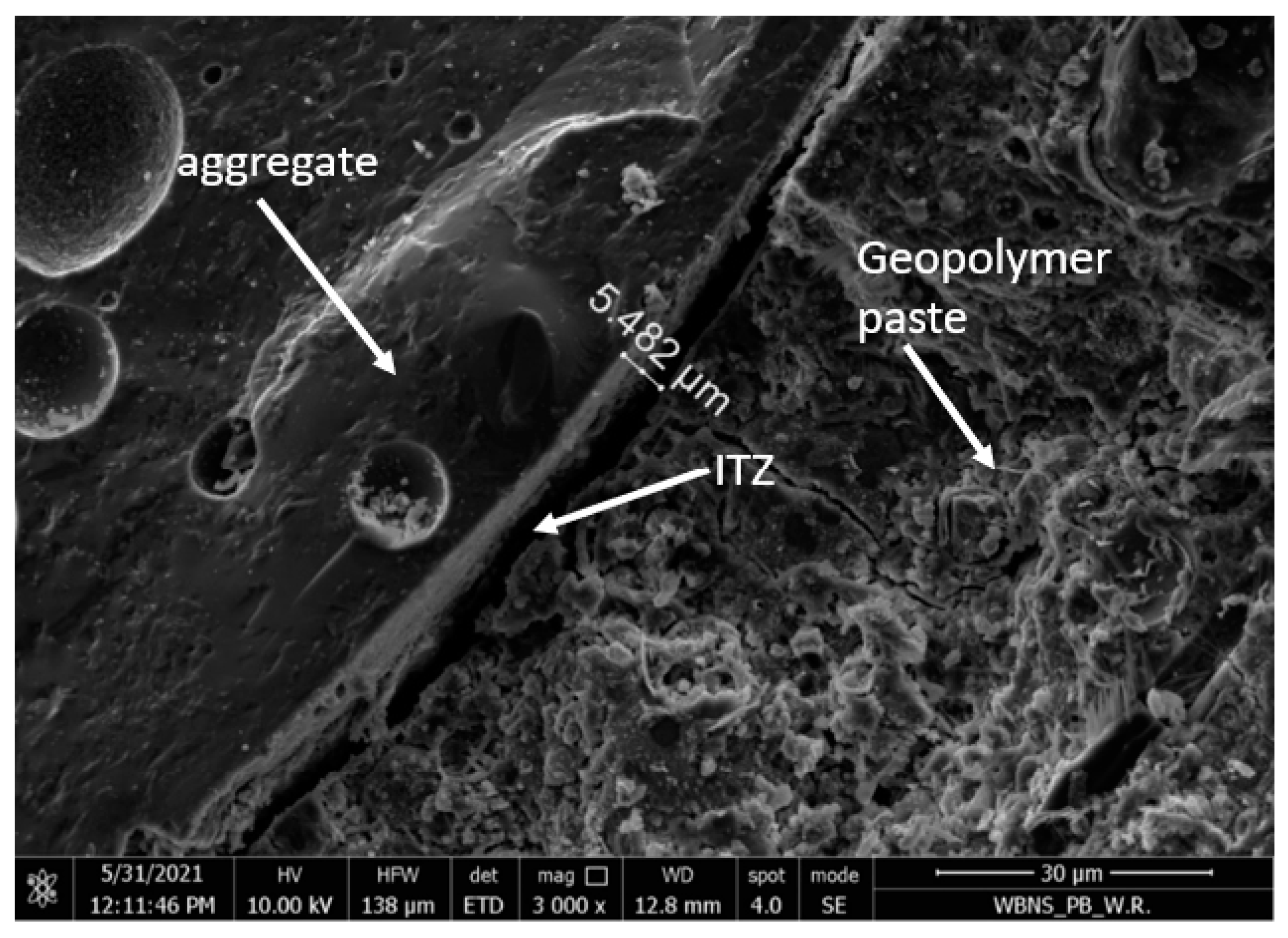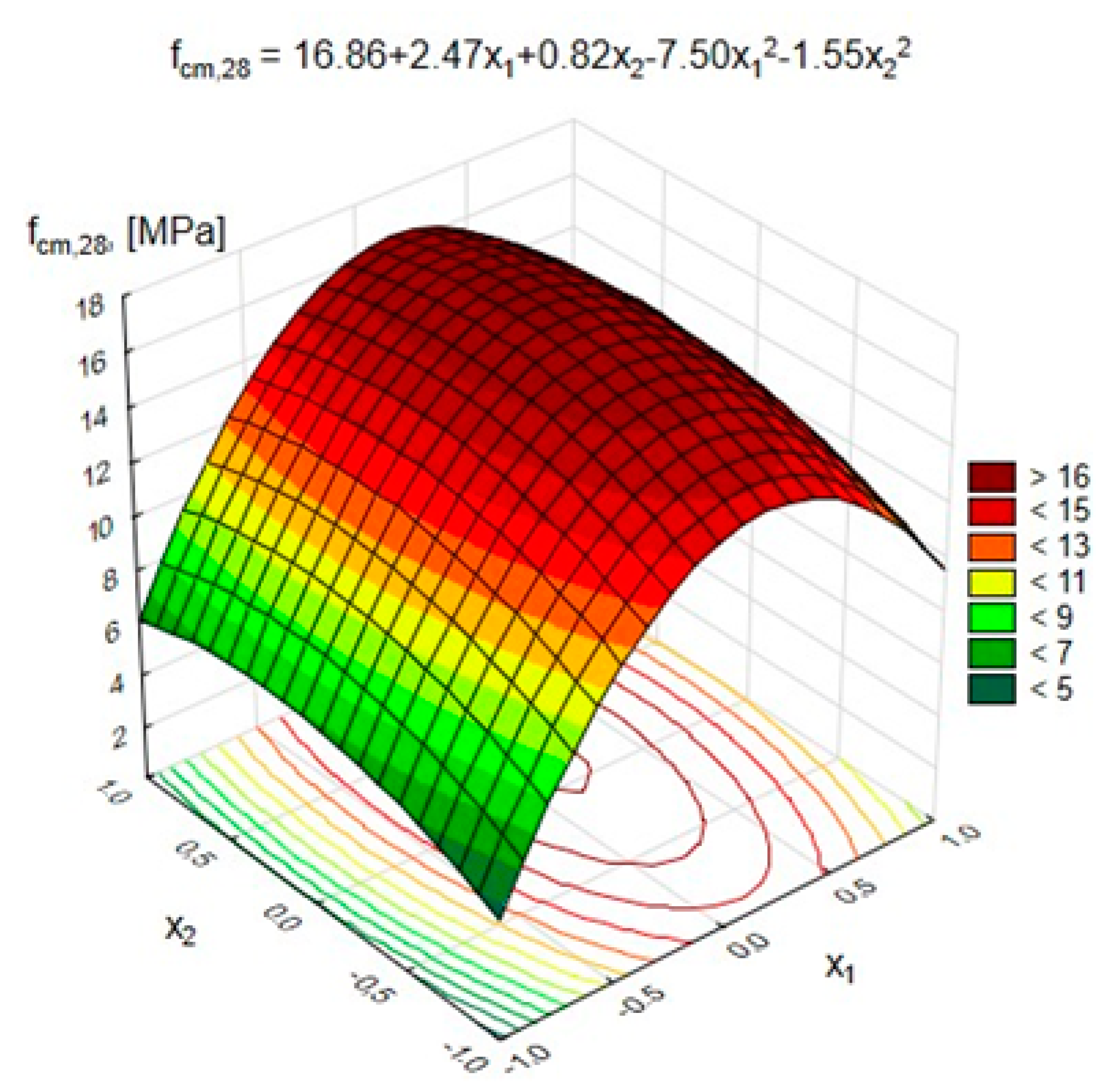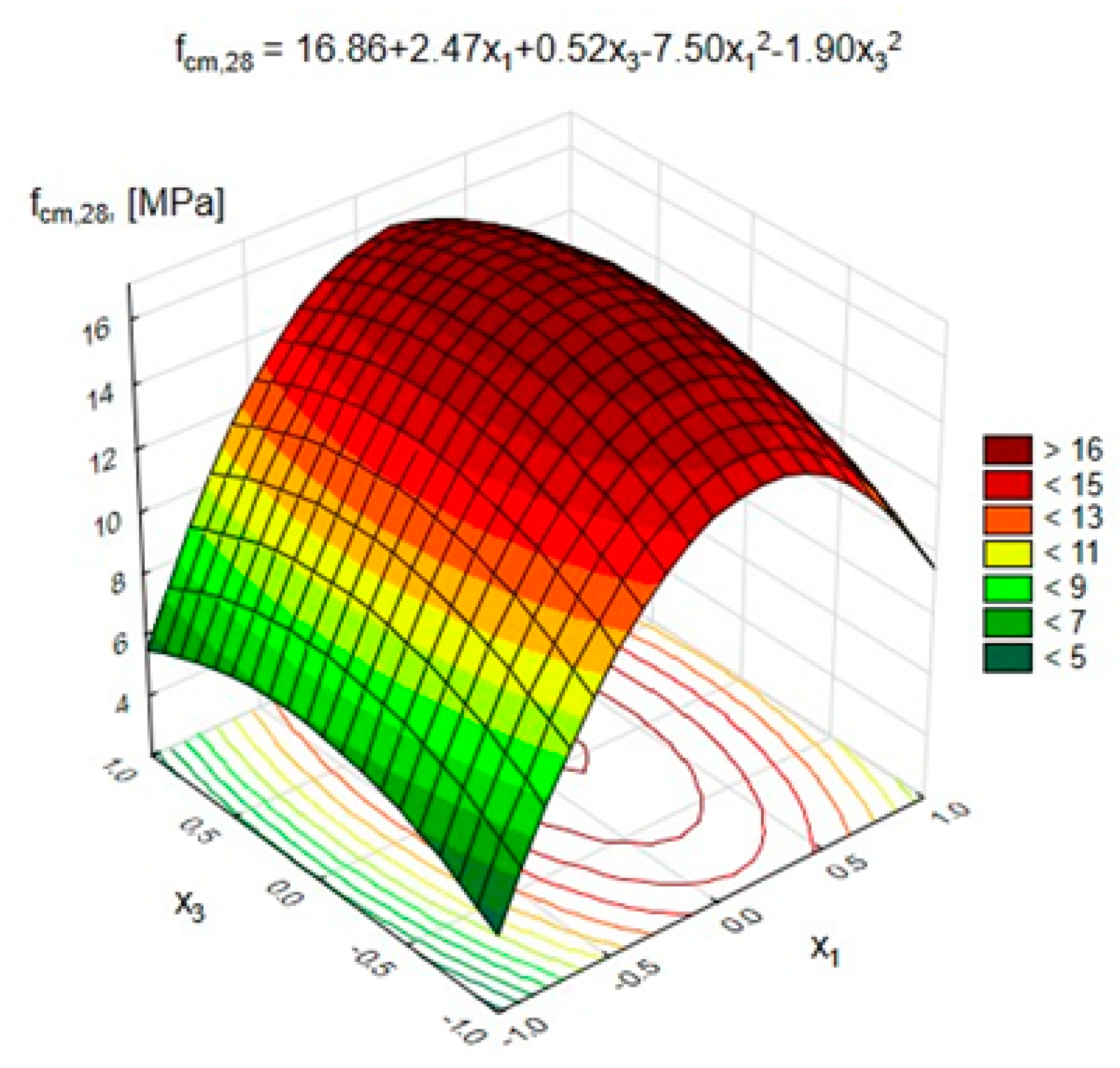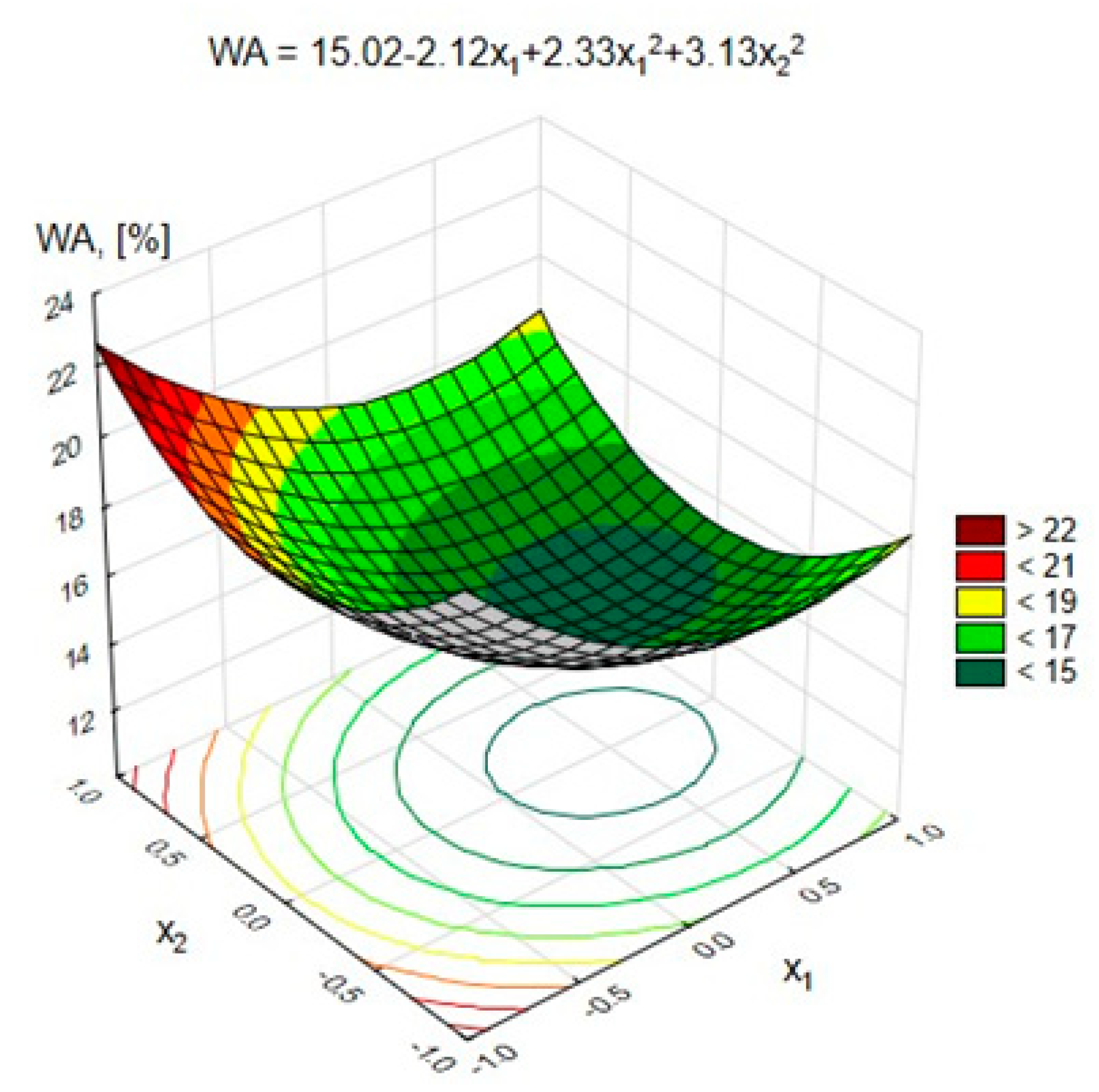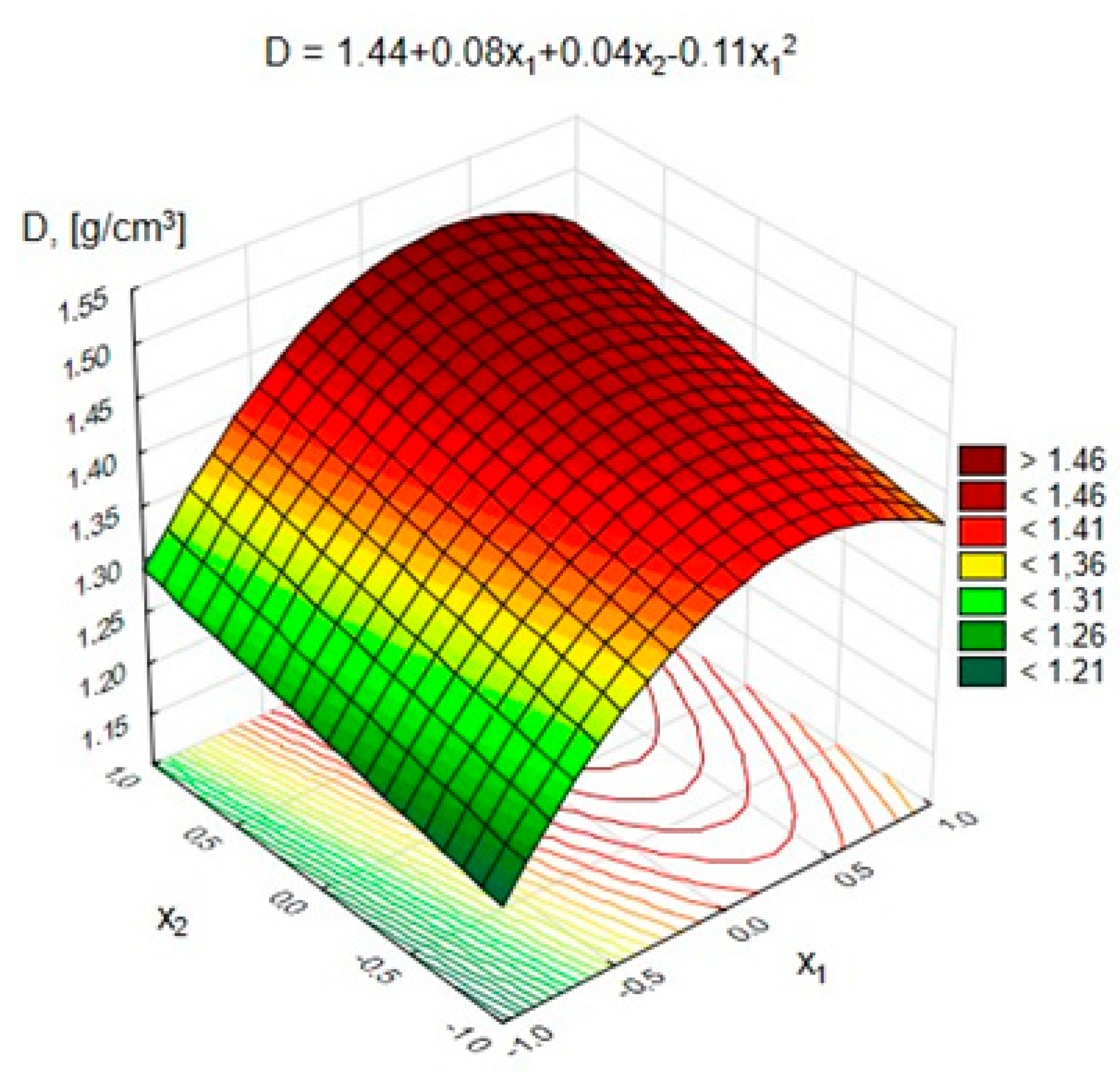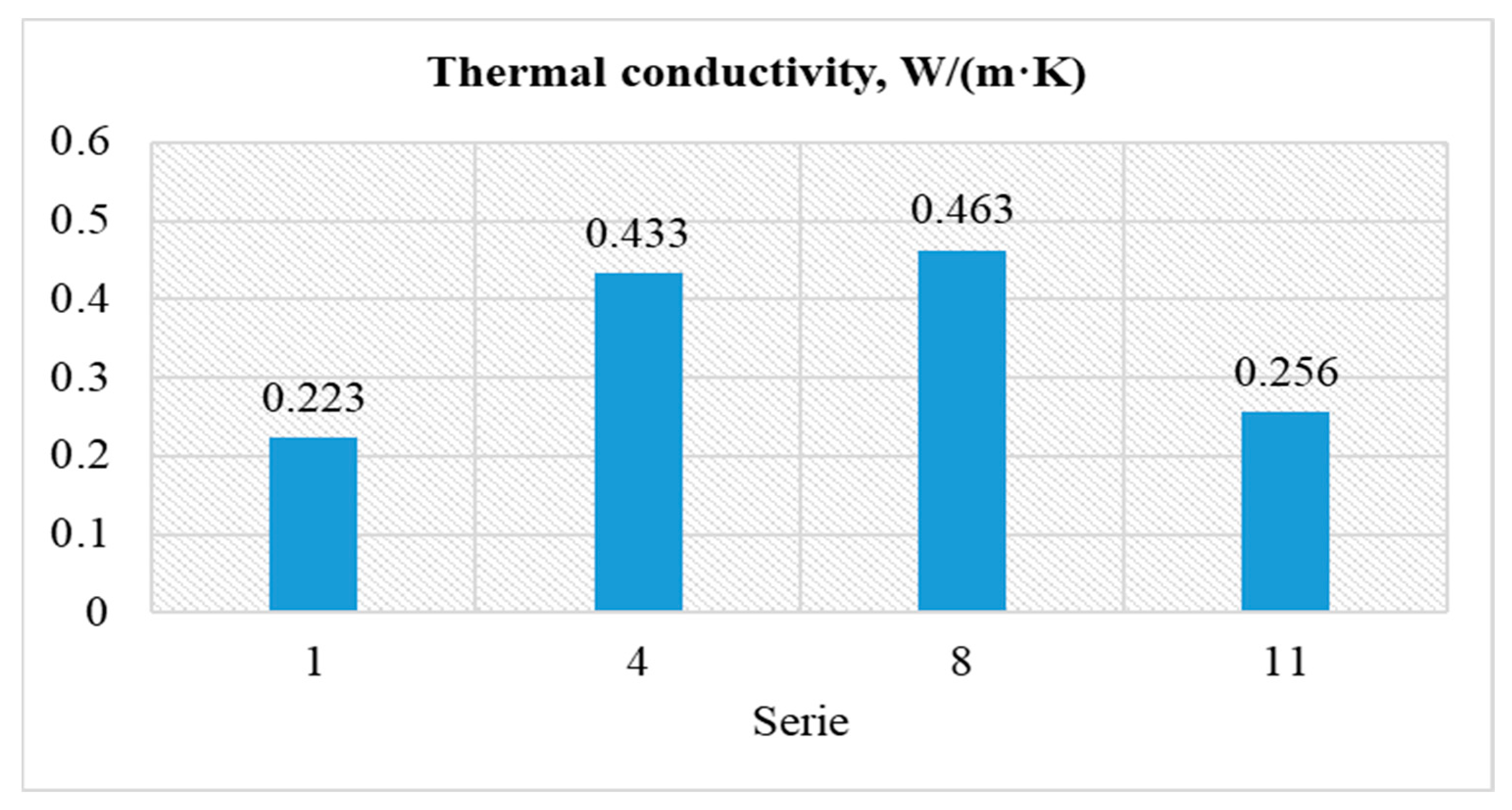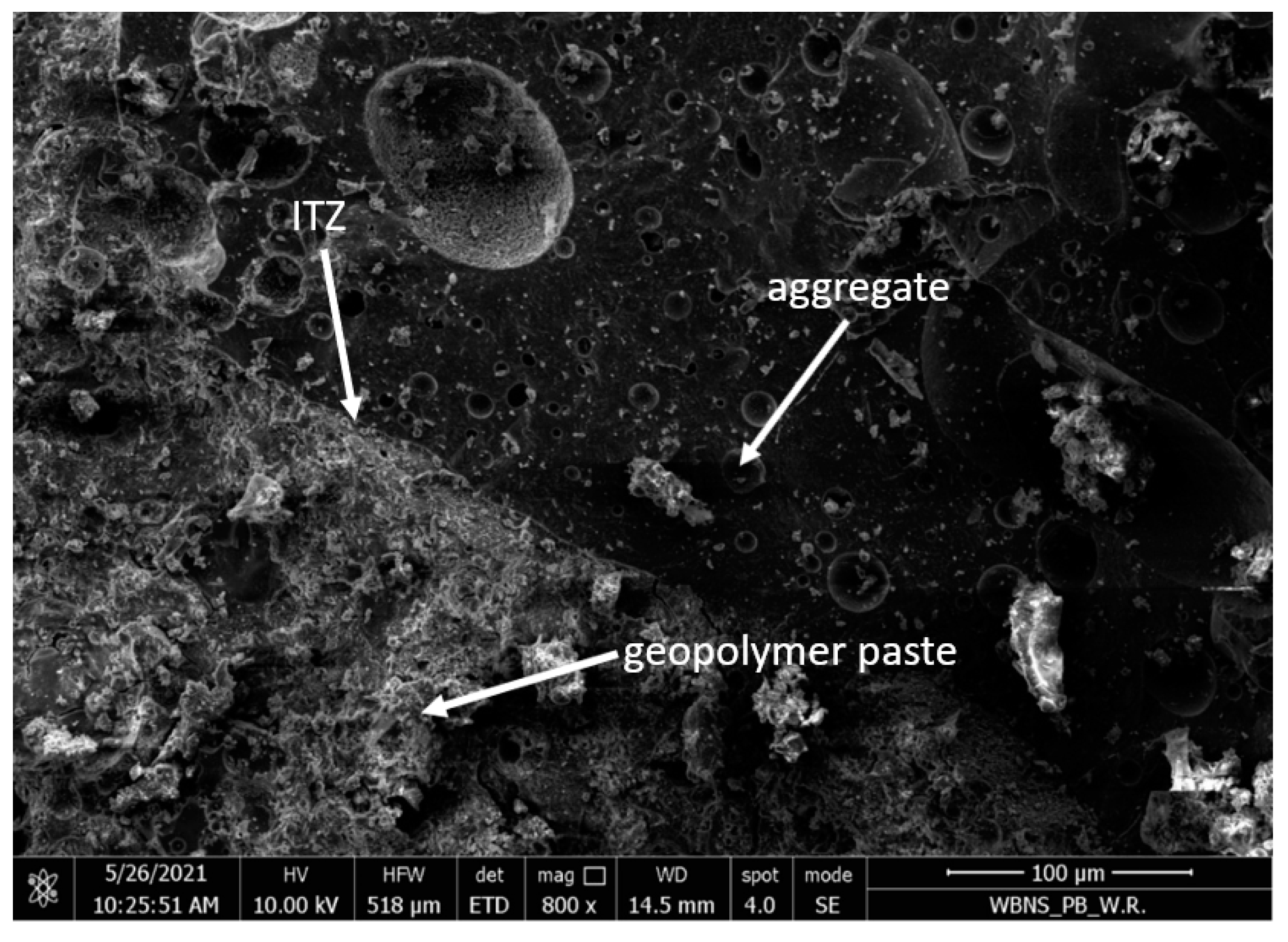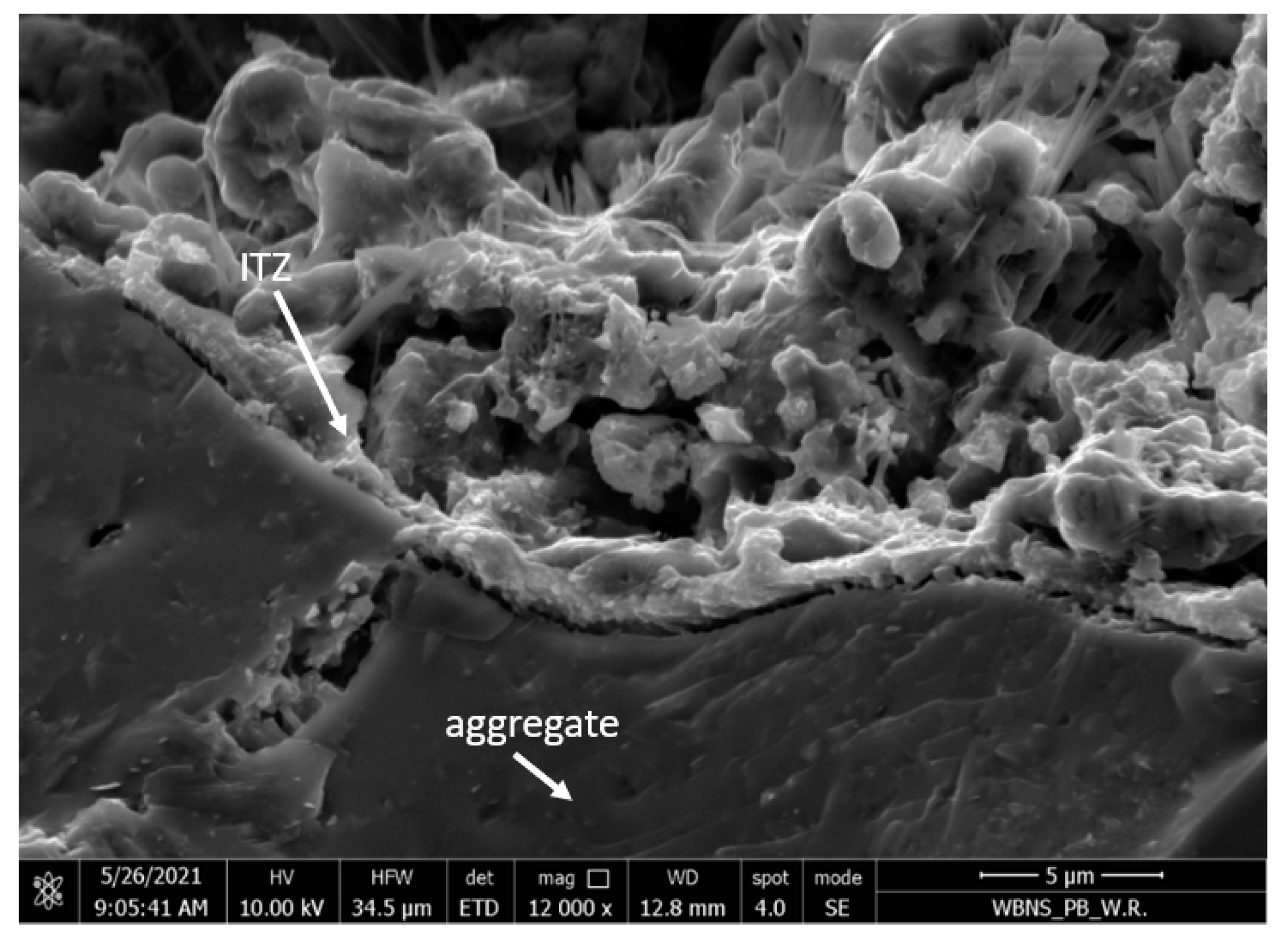1. Introduction
With the increasing demand for natural aggregates, the production and use of lightweight waste aggregates with a chemical composition similar to ceramsite [
1] in geopolymer composites are becoming more popular. It is a good way to utilize, for example, slag [
2] and fly ash [
3] and to obtain lightweight composites [
4] with good compressive strength results [
5]. Due to the fact of their favorable properties and easy availability, artificial aggregates made from clay or swelling slate and fly ash are currently popularly used for cement concretes for both structural and insulating purposes. Due to the presence of several technical problems resulting from the porous nature of lightweight aggregate (LWA), precast applications of the material are preferable and much more common in practice in comparison to monolithic ones [
6]. The impregnation of lightweight aggregate (LWA) is an alternative method to its premoistening, which is used to limit the loss of fresh concrete’s workability due to the aggregate’s ability to absorb a great amount of mixing water [
6]. The aim of this study was to determine the effectiveness of precoating LWAs with cement paste in modifying the properties of concrete composites.
A large number of silica–aluminous substances and other alkaline melts contained in solid waste are similar to the chemical components required for sintered ceramsite, and the preparation of ceramic pellets can be achieved by the reaction between different solid wastes [
7]. A common feature of artificial aggregates is a similar oxide composition. They contain aluminosilicates, which in the presence of a suitable silicate, for example, sodium or potassium silicate, with the addition of a strong base usually of a suitable concentration (NaOH or KOH), can lead to a synthesis reaction and, consequently, the formation of a geopolymer [
8]. The issues of using lightweight aggregates in cement and geopolymer concrete have been the subject of research for many years. In order to improve their tightness, light porous aggregates can be impregnated with various substances, e.g., natural or synthetic polymers [
9,
10], sodium carbonate solution [
11], sodium silicate [
12], or calcium metasilicate [
13]. In addition to the expected sealing effect, the main goal is to provide material for phase change in order to improve the parameters, e.g., freeze–thaw resistance or thermal properties [
14]. On the other hand, lightweight aggregate (LWA) precoated with silicate or carbonate solutions is mainly used due to the increase in the LWA’s tightness, which affects the parameters of concretes. Niyazi Ugur Kockal and Turan Ozturan [
15] investigated the effect of lightweight ash aggregates on the properties of concrete mixtures, the mechanical properties of concrete and the structure of the interfacial transition zone (ITZ). Yiu Lo et al. [
16] conducted research using high-carbon fly ash (HCFA–LWA: high-carbon fly ash–lightweight aggregate) for aggregate production. Microscopic examination of the interphase transition zone showed that the cement grout penetrated the rough surface of the aggregate and improved the quality of the contact zone between the cement grout and HCFA–LWA. The strength of lightweight concrete after 7 days of hardening reached approximately 90% of the 28-day strength.
Since the production of cement concrete is associated with a high level of energy consumption and leads to the emission of large quantities of greenhouse gases, especially carbon dioxide (CO
2), new, greener materials and technologies are being sought [
17]. Ordinary Portland cement and concrete are used globally in the construction industry but have major negative environmental impacts [
18,
19,
20,
21]. In a report documented by Andrew [
20] from the Centre for International Climate Research Oslo (CICERO), Norway, approximately 4 billion tons of cement were produced in 2016 globally [
20]. Nearly 50 billion tons of concrete are produced annually all over the world. The cement industry contributes to approximately 10% of the total greenhouse gas emissions globally and utilizes 1.5 billion gigajoules (GJ) of energy annually. For instance, approximately 0.9 tons of CO
2 are released in the production of 1 ton of cement [
22]. In addition, as the geopolymer raw materials are often waste by-products from other industrial processes (e.g., fly ash and blast furnace slag), their use promotes more sustainable practices in the construction industry both in terms of cost (reduction up to 30%) and greenhouse emissions (reductions up to 80%) [
23].
It can also be noted that better sustainability and reduction in CO
2 emissions in geopolymer production are only possible if the production chain and the design of the mixtures are developed with these results in mind. Sodium silicate, for example, has a high energy and environmental cost (≈0.30 kg CO
2/kg) when produced traditionally. It is necessary to develop alkali-activated products with alternative activators, produced preferably using residual materials and processes that are not aggressive from an environmental point of view [
24].
Hasan Assaedi and Thamer Alomayri et al. [
25] researched the mechanical properties of PVA (polyvinyl alcohol) fiber-reinforced geopolymer composites containing different amounts of nanosilica. The suitable content of nanosilica was established as 1.0 to 2.0 wt%. The PVA fiber-reinforced geopolymer nanocomposites containing 1.0 and 2.0 wt% nanosilica improved the compressive strength, flexural strength and impact strength in comparison to the PVA fiber-reinforced geopolymer composite without nanosilica. The optimum content of NS was found to be 2.0 wt% in terms of the maximum compressive strength of the composites, which was 25.0% higher than the control composites. Recently, carbon nanotubes have been incorporated to increase the various properties of concrete, including its rheological, mechanical and durability properties. Carbon nanotubes were also found to improve the ITZ between aggregates and the cement matrix [
26,
27,
28].
Ojha et al. [
29] prepared mortar samples containing lightweight geopolymer fly ash sand. The mortars conformed to their respective strength requirements but were lower in comparison to the control mix containing fine natural aggregates. The compressive strength of concrete and mortar mixes containing lightweight geopolymer fly ash sand can be improved if an activator solution of slightly higher concentration and increased post-set heat treatment duration is used for the preparation of lightweight geopolymer fly ash sand. For normal grade concrete (in the range of M20 to M30), geopolymer fly ash sand can be a viable and sustainable solution [
29]. Wei and Cheng [
30] added sodium salts to the mixture of fly ash and water glass, which decreased all analyzed parameters of concretes. After analyzing the effect of light fine-grained aggregate activated with alkali on the physical and mechanical properties of composites, Hatice Oznur Oz and Hasan Erhan Yucel [
31] found an improvement in compressive strength. Zou et al. [
32] carried out an experimental investigation on sawdust and metakaolin-based geopolymer and found it to be an effective insulation material for buildings. The samples with a water-to-biomass ratio of up to two were found to exhibit low heat conductivity (0.118–0.125 W/m·K) and were potentially suitable for practical application in building insulations [
32].
Previous research on the properties of geopolymer with lightweight artificial aggregates was mainly concerned with improvements in the quality of lightweight aggregates and their influence on the performance of cement concretes. This paper presents the properties of geopolymer concretes with lightweight artificial aggregate with pozzolanic additives with contents of fly ash and a fly ash–slag mix with NaOH. The formation of fly ash from coal combustion is increasingly being curtailed due to the European Union’s decision to end the mining and burning of mine-produced coal by 2050 [
33]. A significant part of the generated fly ash is used in the production of cement with pozzolanic additives, e.g., road construction or for self-compacting concretes. For this reason, the aim of this research was to determine the degree of replacement of fly ash in lightweight geopolymer concrete (GLC) with an ash–slag mix and the optimal concentration of the activator used in the form of sodium hydroxide was determined. The effect of earlier impregnation of coarse aggregate with NaOH on GLC’s properties was also examined.
5. SEM Observations of Microstructure of the GLC
Scanning photos of the microstructure of the examined geopolymer concrete on artificial aggregate were analyzed using a scanning electron microscope Quanta 250 FEG, FEI, Hillsboro, OR, USA.
Figure 12A shows the structure of the geopolymer concrete with a coarse aggregate with the 4–8 mm fraction, impregnated with NaOH solution at a concentration of 12 M.
Figure 12A shows larger pores in the coarse aggregate partially filled with NaOH solution. This proves that the impregnation with NaOH solution resulted in a mechanical and chemical connection of the geopolymer mortar with the texture of coarse aggregate [
38]. By using the EDS technique, the chemical components on the surface and inside the lightweight aggregate (LWA) in the geopolymer matrix were carried out. The results are shown in
Figure 12B and
Table 10 and also in
Figure 12C and
Table 11.
The chemical components detected in the
Figure 12B and in
Table 10 (Al, Na, O, Si) show that sodium silicates formed on the surface of the lightweight aggregate as a result of the reaction of aluminum oxides on its surface with NaOH, which is also described in [
37]. Different areas were found inside the LWA aggregate (
Figure 12B and
Table 11).
As the results of chemical components show (
Figure 12C and
Table 11), inside the LWA Na and O are detected, which confirm the presence of NaOH in there.
Among other things, for these reasons, a tighter structure of the contact layer between the geopolymer mortar and the surface of the artificial aggregate was obtained (
Figure 13 and
Figure 14), in addition to better strength parameters [
37].
